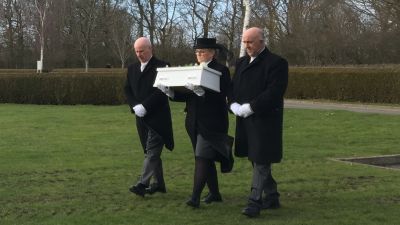Newborn 'Baby S' found dead at Suffolk waste plant 'may have been shaken or smothered'

A newborn baby girl whose body was found at a waste recycling plant during the first national lockdown may have been shaken or smothered to death, an inquest heard.
The unidentified child, who is known only as Baby S, was found on a conveyor belt on a waste processing line in Suffolk on 14 May 2020, during the first national coronavirus lockdown.
Her body was discovered at the Sackers yard in Needham Market after a delivery of waste from commercial bins. She has never been identified and her family never traced, despite repeated appeals from police.
An inquest in Ipswich on Tuesday heard that the baby was born alive but there were several possible causes of her fatal injuries, including a traumatic birth, shaking or smothering, but a pathologist could not determine which it was.
Suffolk’s senior coroner Nigel Parsley, recording an open conclusion, said: “We simply cannot say exactly how Baby S came by her death and how she received the injuries which led to her death.”
He said an initial post-mortem examination could not determine a cause of death, so the baby’s brain and spinal column were sent to a consultant neuropathologist.
Her cause of death was then recorded as due to a traumatic brain injury, with the cause of this unascertained.
This report contains details of injury that some readers may find distressing.
Mr Parsley told Tuesday’s hearing in Ipswich that the post-mortem examination recorded features “compatible with a live birth” such as “well-inflated lungs, indicating active breathing”.
She was recorded to be dark-skinned, possibly of African descent, and to have been born full-term with no evidence of underlying disease.
Det Ch Insp Karl Nightingale, the senior investigating officer, agreed with Mr Parsley that Baby S was “definitely born alive” and was no more than 24 hours old.
Baby S had “numerous severe injuries”, a pathologist’s report said, with the “majority” occurring after death including fractures to the skull, pelvis and ribs which “could be explained by damage through the processing plant”.
Det Ch Insp Nightingale said pathologists were “significantly hindered by the waste processing she went through” but they identified injuries which “happened prior to her death”.
The report noted haemorrhaging to the layer covering the skull and bruises to the front of the face and over the mouth.
“She could have been placed into the bin while alive but her death isn’t attributed to her going through the waste processing,” he said.
He said pathologist Dr Virginia Fitzpatrick-Swallow identified a number of possible mechanisms which could have caused the injuries to Baby S, including a traumatic birth, smothering or shaking.
“She isn’t able to define which of these mechanisms caused her death and she’s not able to prioritise those into a hierarchical list to say which is most likely,” added Det Ch Insp Nightingale.
He said Baby S was thought to have been inside one of two waste collection vehicles which collected waste from 52 locations.
Officers visited 800 addresses and gathered 11,000 hours of CCTV footage but were not able to establish how Baby S came to be inside a bin.
He said police “have to keep an open mind” about the case.
Mr Parsley said: “All we can say with any certainty is the information in relation to how Baby S was found but really we’re no closer to identifying how she got into the waste system in the first place.”
He described the case as “tragic” and praised Sackers for helping in the course of the investigation.
The coroner noted the firm had been “fundamentally involved in funeral arrangements” for the infant.
Police have previously said Baby S's mother “may have been in contact with fewer people than normal” as there was a national lockdown “but her pregnancy and giving birth may have been apparent and we need people with information to share that with the police”.
A funeral was held for Baby S in February.
Want a quick and expert briefing on the biggest news stories? Listen to our latest podcasts to find out What You Need To Know